I knew my Swedish immigrant great grand Uncle Erick Dalin was a veteran of WWI. What I didn’t fully appreciate until recently was that he volunteered to serve – at age 49!
It’s time to learn a little more about Erick’s military experience.
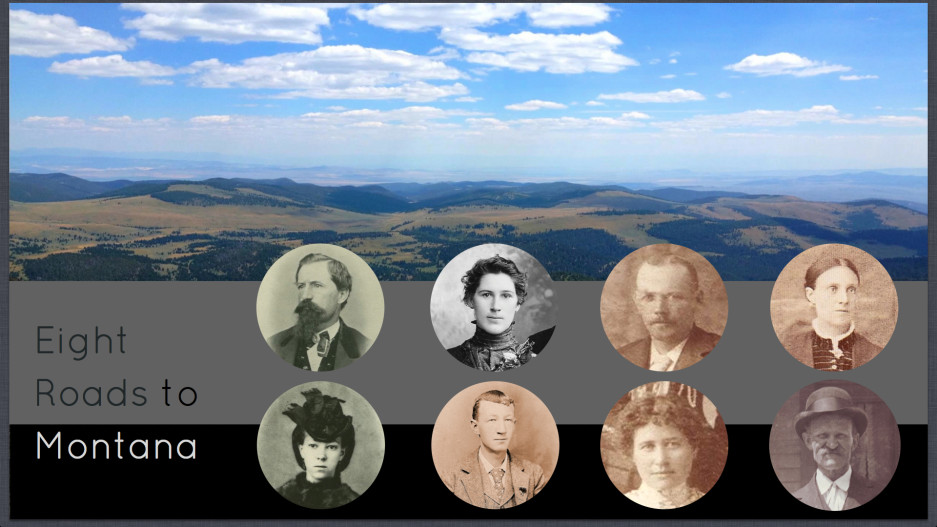
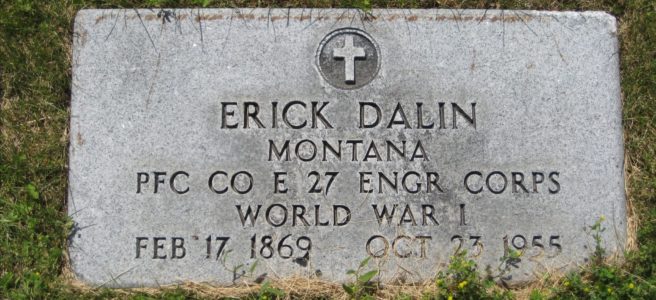
I knew my Swedish immigrant great grand Uncle Erick Dalin was a veteran of WWI. What I didn’t fully appreciate until recently was that he volunteered to serve – at age 49!
It’s time to learn a little more about Erick’s military experience.
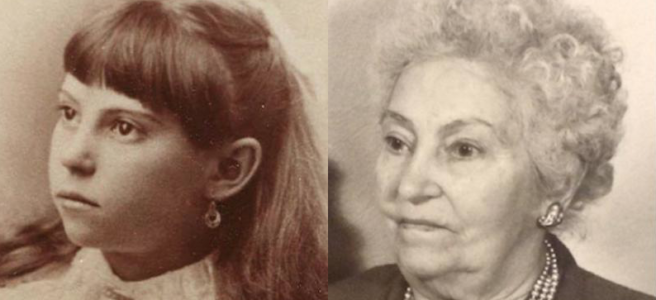
Inspired by an article entitled “Then and Now Photos Show People as Young Adults and at 100 Years Old”, I took a look at some of the family photos in my own collection to see if I could assemble a similar group.
The results were somewhat surprising. Most noteworthy . . .
Here’s my collection . . . Continue reading
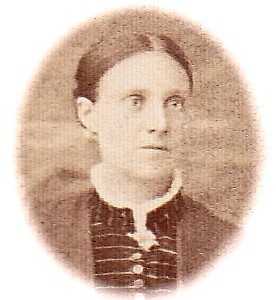
[This series on Brita’s trip from Sweden to North America begins here.]
In Part 1 of this series, Brita Johansdotter left her home in Hudiksvall, Sweden for the last time on Sunday, January 22, 1893.
Four years after her husband emigrated to America.
Nine months after her son Johan died.
Five days after taking her daughter Helena to live with another family.
The first leg of her journey – from Hudiksvall to Göteborg – can only have been filled with sadness and anxiety.
And so I found myself wondering about her trip to Göteborg. What was her mode of transportation? And how long did the journey last?
After doing some research, it seems most likely she would have made the trip by train, since rail lines were well established by that time.
This map illustrates the rail lines in place by 1910. I outlined in red the route she might have travelled.
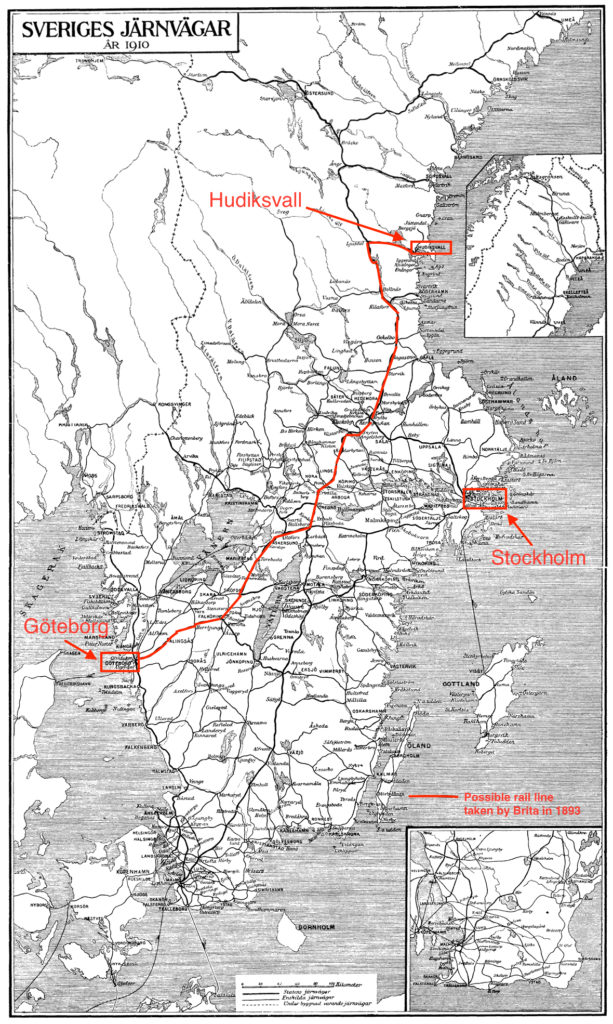
Twenty-four hours to remember all that had gone before and ponder what might lie ahead.
Depending on when she left Hudiksvall on January 22nd, Brita would have probably arrived in Göteborg on either January 23rd or 24th – assuming there were no overnight or lengthy stops along the way.
We know that her ship sailed on Friday, February 10th. So what did she do for two weeks while waiting to continue her journey?
In Part 3 of Brita’s trip from Sweden to North America, I’ll cover what I’ve learned about how she might have spent her time in Göteborg and give some detail on the next leg of her trip.
On Tuesday, January 17, 1893, twenty-nine year old Brita Johansdotter1, wife of Anders “Andrew” Dalin2, and mother of two children, Johan and Helena, awoke knowing that the following Sunday she would leave her home in Hudiksvall, Sweden – for the last time.
Her first destination would be Göteborg, a seaport on the west coast of Sweden, where she would board a ship headed for North America.
After four long years, she would finally join her husband who emigrated in January of 1889.
But I suspect that her very first thoughts that morning were of her two children. Johan would not make the trip because he had died nine months earlier at the age of 4. And little Helena, who had just celebrated her first birthday only a few weeks earlier, would not make the trip . . . because she was not Andrew’s daughter. And now the day had finally come when Brita had to face that reality head on.
Four years earlier, on January 5, 1889, Brita’s husband Andrew and his brother Eric left Hudiksvall to emigrate to “Nordamerika”.3 Prior to that date, Andrew and Brita had been living with Andrew’s parents, Lars Andersson and Brita Anderssdotter,4 since the time the couple married on October 30, 1887.5
On December 27, 1887, a son – Johan – was born to Andrew and Brita.6
Brita continued living with her in-laws after Andrew left. And several years later, she became pregnant – and obviously, Andrew was not the father of the expected baby.
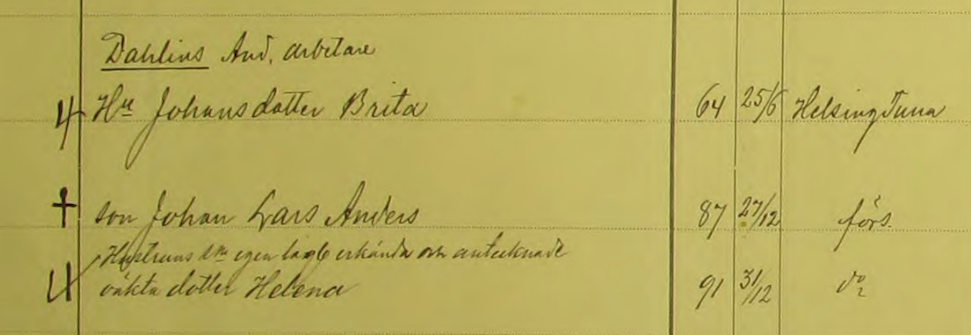
Surprisingly, Brita stayed on with her in-laws during that time 7 and her daughter Helena was born on December 31, 1891.8
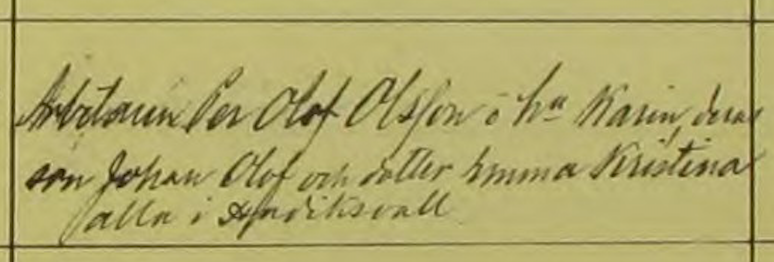
The new baby was baptized several months later on February 27th and the “Dopvittnen” (baptismal witnesses) are listed as Per Olof Olsson, his wife Karin, son Johan Olof, and daughter Emma Christina – the same family with whom Helena went to live when her mother emigrated a year later.9
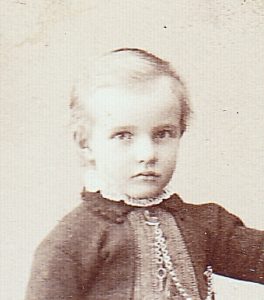
Three and a half months after Helena’s birth, Brita’s four-year-old son Johan died on April 1, 1892, of a lung inflammation.10
And now the day had arrived – January 17, 1893 – when Brita had to face the reality of leaving her one-year-old daughter behind. The emotional pain must have been unbearable.
Most of the information above was discovered during research I conducted over several months last year, primarily from records located at ArkivDigital.
The records I discovered regarding Johan were not a surprise, as my father told me about him years ago. But he did not tell me about Helena – and I suspect he never knew about her.
Once the pieces of the story came together, I had many questions . . .
Many questions.
In Part 2 of this story, I’ll cover Brita’s overland trip from Hudiksvall to Göteborg.